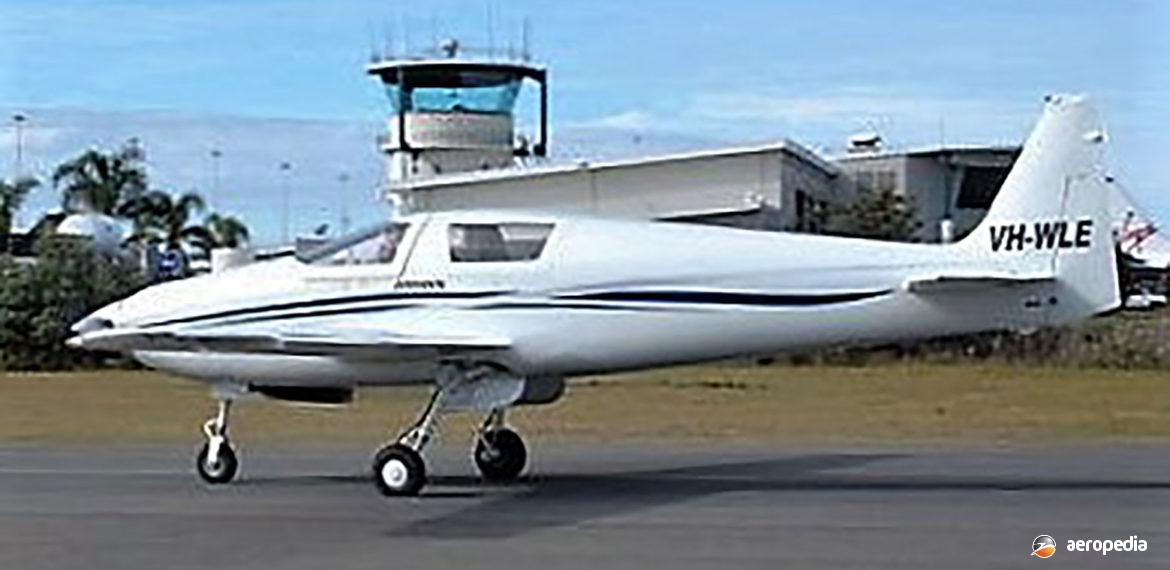Photograph:
Reflex White Lightning VH-WLE (c/n 24) at Jandakot, WA (Author’s collection)
Country of origin:
United States of America
Description:
Four-seat, light, high-performance sport monoplane
Power Plant:
One 157 kw (210 hp) Continental O-360 CB four-cylinder horizontally-opposed air-cooled engine
Specifications:
- Wingspan: 8.43 m (27 ft 8 in)
- Length: 7.11 m (23 ft 4 in)
- Height: 2.18 m (7 ft 2 in)
- Wing area: 8.27 m² (89 sq ft)
- Max speed: 450 km/h (280 mph)
- Max cruising speed at 2,440 m (8,000 ft): 426 km/h (265 mph)
- Economical cruising speed at 3,350 m (11,000 ft): 410 km/h (255 mph)
- Stalling speed clean: 148 km/h (92 mph)
- Stalling speed, flaps down: 108 km/h (67 mph)
- Max rate of climb at sea level: 579 m/min (1,900 ft/min)
- Service ceiling: 7,010 m (23,000 ft)
- Take-off run: 381 m (1,250 ft)
- Landing run: 397 m (1,300 ft)
- Range with max fuel: 2,575 km (1,600 miles)
- Fuel capacity: 257 litres (56.6 imp gals)
- Endurance: 6 hrs 10 mins
- Empty weight: 635 kg (1,400 lb)
- Payload: 590 kg (1,300 lb)
- Loaded weight: 1,088 kg (2,400 lb)
History:
The White Lightning was designed by Howell C Jones Jr for White Lightning Aircraft Corp of Walterboro, South Carolina, USA and production of kits for amateur constructors began in September 1986. In more recent times the design has been available from Reflex Fiberglass Works also of Walterboro, South Carolina. It was a four-seat high-performance sporting monoplane with a retractable undercarriage. The prototype was flown for the first time on 8 March 1986 and in that year it established several world speed records in Class C1b and C1c. It was supplied in kit form, some 28 being delivered by January of 1991. It could be obtained in four separate kits so it could be constructed in easy stages.
Engines installed were usually in the 149 kw (200 hp) to 186 kw (250 hp) range, depending on the builder’s preference, driving a wood and fibreglass propeller made by Hoffmann GmbH & Co KG. The wing section was NACA 66²-215 and it is of graphite tubular ‘wet’ main spar, with fibreglass/epoxy front and rear spars and ribs, all pre-cased in the lower fibreglass/epoxy skin. It had fowler flaps, the fuselage was moulded in two halves, upper and lower, and it was also of fibreglass/epoxy construction. The tail unit had spars and ribs, the tailplane being pre-cast into one skin of each. The undercarriage was retractable and G limits in the utility category were +4.4 / – 2.
Construction techniques were innovative in that the fuselage, instead of being built of right-hand and left-hand halves, was built as top and bottom moulded shells, the top being put in place after most of the control linkages and other systems had been installed in the lower fuselage section. The bulkheads, main undercarriage attachment points and tubular carry-through spar were pre-installed in the bottom half of the fuselage. The wing was made available with many internal structures fastened in place. Static load tests indicated the airframe should withstand 12Gs.
About 100 kits have been supplied to amateur builders, and one much modified example has been a regular competitor at the Reno Air Races in Nevada, USA in recent years. First of the type seen in this region was WLAC 1 White Lightning VH-WLE (c/n 24), construction of which was initially undertaken in the United States, before being imported to Australia, where further construction took place at Ballarat, VIC. It was completed at Coolangatta, QLD in early 2005. It was fitted with a Continental O-360-D engine. In 2010 ownership was transferred to Mr G Sim of Mt Kembla, NSW.

